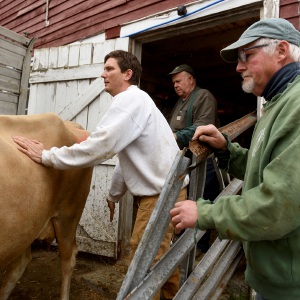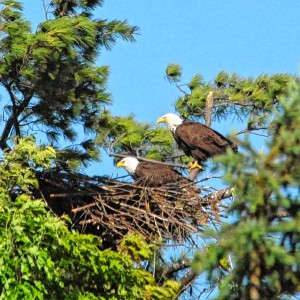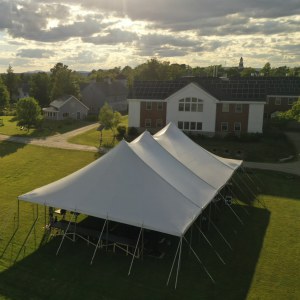Return of the Native Elm
| Published: 05-22-2016 10:00 PM |
After World War II, Dutch elm disease began its decimation of the American elm, a tree that was the glory of hundreds of Main Streets in the Northeastern and Midwestern U.S.
At the same time, it also affected the American elm’s lesser-known cousin, the slippery elm, a staple tree in watersheds from New England down to Texas and Oklahoma.
In 2010, the Connecticut, Massachusetts, New Hampshire and Vermont chapters of the Nature Conservancy began a restoration project of both the American and slippery elms in the Connecticut River watershed.
By the time the propagation and planting program is completed in five years, the conservancy will have planted between 5,000 and 10,000 elms, the majority of them American elms that have been propagated from disease-resistant trees.
The slippery elm also has its place in the ecosystem, however.
Last year the Vermont Nature Conservancy planted 80 slippery elms in a field trial on a 186-acre parcel in the White River Ledges Natural Area on the Sharon-Pomfret line, one of 55 protected properties it owns in the state, and one of two in the Upper Valley. (The other, Eshqua Bog in Hartland, is known for its showy lady’s slippers.)
Earlier this month, a team from the Vermont Nature Conservancy went out to check on the slippery elms for the first time since they were planted last spring.
Lynn McNamara, critical lands manager for northern Vermont, and Karla Noboa and Josh Jones, two AmeriCorps volunteers working with the conservancy, were there to record which elms had survived the winter, and their height and width.
Article continues after...
Yesterday's Most Read Articles
 Herd departs Hartford’s last remaining dairy farm
Herd departs Hartford’s last remaining dairy farm
 Bald eagles are back, but great blue herons paid the price
Bald eagles are back, but great blue herons paid the price
 At Dartmouth, hundreds protest ongoing war in Gaza and express support for academic freedom
At Dartmouth, hundreds protest ongoing war in Gaza and express support for academic freedom
 Kenyon: What makes Dartmouth different?
Kenyon: What makes Dartmouth different?
 Big drop in tuition and aid is boosting Colby-Sawyer
Big drop in tuition and aid is boosting Colby-Sawyer
To protect the saplings from being gnawed by rodents, including beavers, the trunks were wrapped in tree tubes at planting.
Weed mats at the base of half the trees suppressed overgrowth by vegetation. The team placed mats at only half the trees because they weren’t sure which had the potential for more damage: overgrowth or rodents nesting under the mats.
“Our goal is to give them as much of a head start as possible,” McNamara said.
To the team’s surprise, most of the slippery elms had made it through the year. Noboa and Jones found only a handful of dead or dying elms, and many of the elms were doing well, with leaves budding out. One elm had been strangled by a Virginia creeper vine.
“It’s amazing to find as many live elms as they have. There are so many things that will kill them,” McNamara said.
Until it was ravaged by Dutch elm disease, the slippery elm, so-called because its inner bark is slightly viscous, was an important part of riparian environments.
Unlike the American elm, which tolerates floodplain, the slippery elm prefers higher ground, said Christian Marks, interviewed by phone from Northampton, Mass., where he is a floodplain ecologist with the Nature Conservancy.
The slippery elm is prevalent along the Connecticut from Woodsville down to Lebanon, and on some of the Upper Connecticut tributaries in Vermont, Marks said.
It was never as common in urban or suburban plantings, largely because it lacks that graceful vase shape that made the American elm so sought after for parks, small town streets and back yards, he added.
Also called red elm, because of the color of its wood, the slippery elm is, like the American elm, a shade tree that is part of the super canopy and cools rivers, making them more hospitable for trout, McNamara said. When a disease-tolerant elm tree reaches maturity, it can be 60 feet high, and sometimes taller.
Because the slippery elm thrives in soils that have a higher pH, the conservancy chose the White River location for its natural nursery, McNamara said.
That stretch of the White River is notable because of the calcium-rich water seepage from the limestone and marble bedrock that occurs along the river banks and promotes the growth of unusual grasses, mosses and sedges.
There is also seepage from the ledges on the hillsides that rise above the floodplain, McNamara said. The field in which the slippery elms are planted is a level above floodplain, which makes it an ideal environment for them.
The slippery elms were propagated from cuttings taken from trees that showed resistance to Dutch elm disease, and grown in a nursery at Green Mountain College in Poultney.
The Nature Conservancy also works in partnership with the U.S. Forest Service to propagate controlled crosses of the American elm at the Forest Service’s Northern Research Station nursery in Delaware, Ohio, which was the first state to experiment with elm restoration in 2003. The seedlings then go to the Poultney nursery before they are planted in field trials.
While the elm restoration project is taking place in Massachusetts, New Hampshire, Vermont and Connecticut, the majority of the elms are being planted in Vermont, which is just the way it worked out, Marks said.
Since 2003, elm restoration projects have spread to Minnesota, Wisconsin, Iowa, Kentucky, West Virginia, Pennsylvania, Virginia, Tennessee and Alabama.
In parallel efforts, the University of Minnesota and Guelph University in Ontario are also working on elm restoration. Because of the geographic range of the elm, Marks said, it is too big a job for any one organization to undertake alone.
The American and slippery elm restoration project being undertaken by the Nature Conservancy is just one incarnation of the decades-long effort to revive the trees, said Marks.
“People started working on this when Dutch elm disease started killing street trees,” he said. Over the years, researchers and scientists would occasionally find a “tree that had elevated tolerance to disease.”
Taking cuttings from resistant trees, or pollen from their buds, scientists and arborists began the work of trying to breed elms that showed tolerance of Dutch elm disease. Those cultivars were then released to the horticultural and nursery industry, Marks said.
If there is one advantage to Dutch elm disease, Marks said, it is that disease-resistant American elms are now easier to find because they’re the trees still standing. Because it’s likely, he said, that they have been exposed to the disease multiple times over the years, they are good candidates for propagation. An elm must be more than 3 feet in diameter to qualify.
“We test those trees and the hope is to increase that number of disease-tolerant cultivars to where we have enough variety to repopulate the natural populations,” Marks said.
Why some elms are resistant while others aren’t is the big question, and it seems to depend on whether they were infected through the crown or the roots.
Disease-tolerant elms infected through the crown seem to be able to contain the disease by sacrificing a limb or branch to it, Marks said. In effect, they wall it off. But if a tree is infected through the roots, it almost certainly will die, Marks added.
This is why streets lined with American elms lost so many, if not all, of them, Marks said. Because the root system of one elm touched another, the elms went down like dominoes. When Marks, or other conservancy workers plant elms now in the wild, they make sure to alternate them with other trees.
What’s gained if and when American and slippery elms are restored to floodplain forests?
A number of things, Marks said.
Because both trees flower and produce seed in early to mid-spring, which coincides with receding waters from snow melt and rain, they provide food to rodents and insects at a time of year when other trees are barren of fruit. And as insects feed, they attract birds migrating along riparian flyways, which then feed on the insects.
For bald eagles, elms were also a favored nesting tree. When the elms died off, eagles had to adapt to cottonwood and white pine, whose upward-pointing branches more closely approximate that of the elm, Marks said. If elms return, the eagles will have a better tree in which to nest.
Marks is cautiously optimistic that the program of genetic cross-breeding from disease-tolerant trees can bring back the American and slippery elms to the Connecticut River watershed, and to New England.
“That approach has worked with numerous crops,” he said. “It should also work with the tree, but it takes longer. ”
Nicola Smith can be reached at nsmith@vnews.com.
]]>

 JAG Productions announces closure, citing ‘crisis facing the arts’
JAG Productions announces closure, citing ‘crisis facing the arts’
